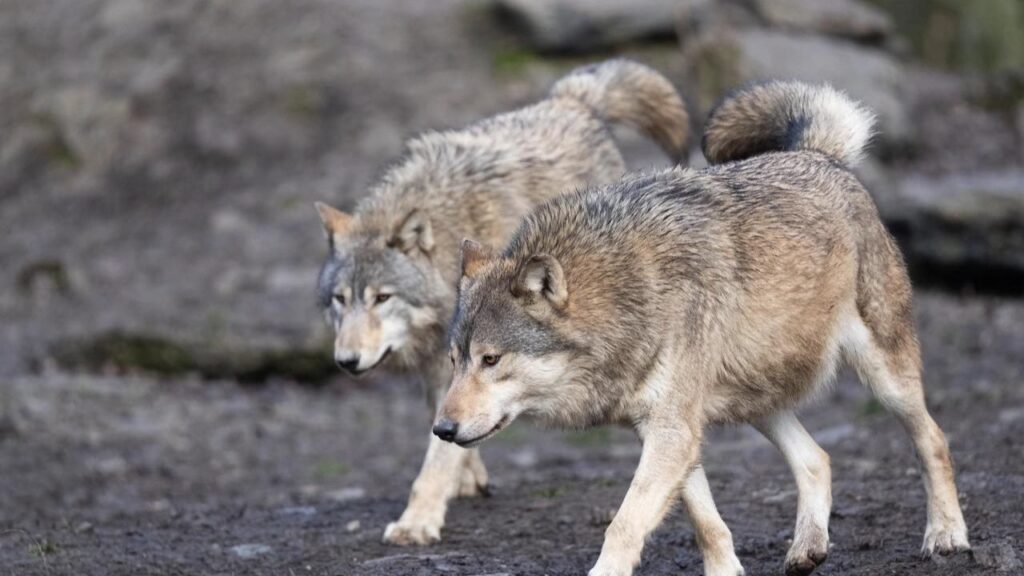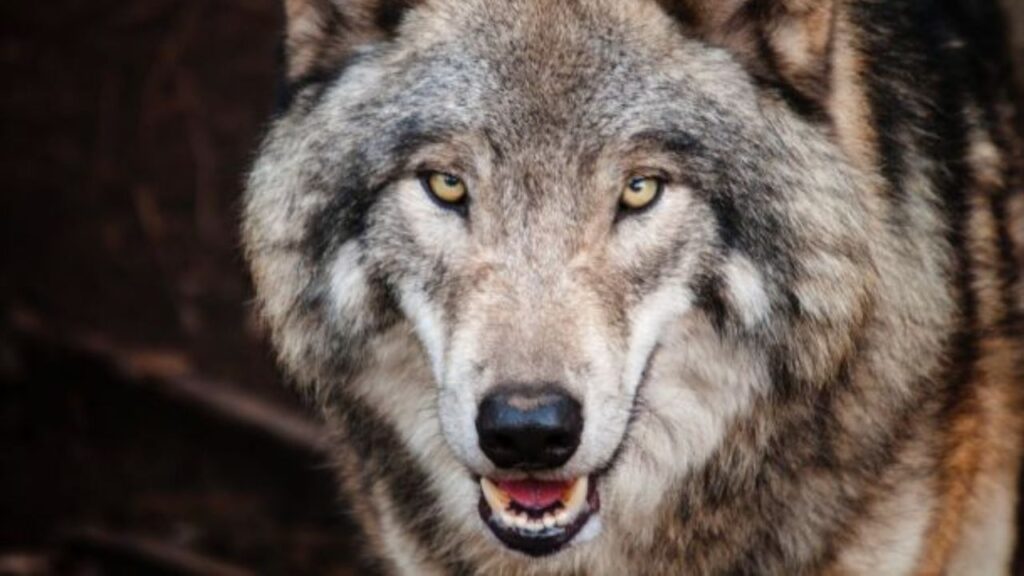Do Timber Wolves Attack Humans? Timber wolves are generally shy and avoid humans, with attacks being extremely rare. Most incidents involving wolves occur when they feel threatened.
Timber wolves, often portrayed as fearsome predators, evoke a blend of fascination and fear.
These majestic creatures, which roam vast territories across North America, Europe, and Asia, are often misunderstood due to centuries of myths and exaggerated tales.
Known for their piercing eyes and sharp instincts, timber wolves play an integral role in maintaining the balance of their ecosystems. But with their intimidating appearance, many wonder: Do timber wolves attack humans?
This article will explore the truth about timber wolves, their behavior, and whether humans have anything to fear from these iconic creatures.
Contents
What Are Timber Wolves?
Characteristics of Timber Wolves
Timber wolves, also known as gray wolves, are the largest members of the wild dog family, Canidae. Their size, strength, and hunting prowess make them apex predators in their habitats.
Typically weighing between 60 to 130 pounds and standing around 26-32 inches tall at the shoulder, they are robust animals built for survival in the wild.
Their thick fur coats, which vary from gray to brown, black, or white, provide insulation during harsh winters. [Do Timber Wolves Attack Humans?]
Wolves are known for their complex social structures. They live in packs, with each pack led by an alpha male and female.
These packs work as highly efficient hunting teams, bringing down large prey such as elk, moose, and deer. A single wolf cannot overpower such prey, but the teamwork and strategy of the pack ensure success.
Wolves communicate with each other using vocalizations, body language, and even facial expressions, making them some of the most socially intelligent animals in the wild.
Habitat and Range of Timber Wolves
Once abundant across much of the Northern Hemisphere, timber wolves have seen their range drastically reduced due to human activity, hunting, and habitat loss.
Today, timber wolves are found in remote forests, tundras, and mountainous regions where they can roam freely without much human interference.
In North America, they are most commonly seen in Alaska, Canada, and parts of the Northern U.S., such as Minnesota, Wisconsin, and Michigan.
Some populations also exist in parts of Europe and Asia, where conservation efforts are helping to reintroduce and protect them.
Wolves are territorial animals, and each pack has its own range, which can span hundreds of square miles. [Do Timber Wolves Attack Humans?]
This territorial behavior keeps wolf populations spread out, reducing the likelihood of human encounters in more populated areas.

Do Timber Wolves Attack Humans?
Are Timber Wolves Dangerous to Humans?
The idea of wolves attacking humans has been deeply ingrained in popular culture, but the reality is far less dramatic.
Timber wolves are naturally shy and wary of humans. They avoid contact whenever possible, and actual wolf attacks on people are exceedingly rare.
Unlike other large predators like bears or big cats, timber wolves do not see humans as prey. Instead, they view humans as a potential threat, and their instinct is to flee rather than fight.
Wolf attacks on humans are almost unheard of in modern times, particularly in North America. In fact, documented cases of wolf attacks are so rare that they barely register compared to encounters with other large wildlife.
When attacks do occur, they are often the result of unusual circumstances, such as the presence of rabies or extreme desperation due to starvation. [Do Timber Wolves Attack Humans?]
Reasons for Timber Wolf Attacks
While it is true that timber wolves rarely attack humans, there are a few scenarios in which an attack could occur. Understanding these rare instances helps us better navigate coexistence with these creatures.
- Rabies: Rabid animals behave unpredictably and aggressively, attacking without fear or provocation. In such cases, wolves may attack humans, as rabies causes erratic and dangerous behavior. Fortunately, rabies in wolves is extremely rare, especially in regions with successful rabies vaccination programs.
- Habituation: Wolves that have become accustomed to human presence—typically due to being fed by people—may lose their natural fear of humans. This can lead to dangerous situations where wolves see humans as a food source or lose their wariness, increasing the likelihood of an attack. Wildlife experts strongly discourage feeding wolves for this reason.
- Food Scarcity: In areas where food is scarce, wolves may become more aggressive out of desperation. This is particularly rare in modern times, as most wolves have access to adequate food sources in the wild, but in areas where prey populations have diminished, wolves may approach human settlements in search of food.
- Perceived Threat: Like most animals, timber wolves will defend themselves and their pack members if they feel threatened. Wolves, particularly those with pups nearby, may react aggressively if humans venture too close to their den or territory.
Historical Instances of Timber Wolf Attacks
Documented instances of timber wolves attacking humans are few, particularly in North America, where wolf-human interactions have been closely monitored for decades.
Most recorded attacks on humans involve rabid wolves, which are an anomaly and not representative of typical wolf behavior. [Do Timber Wolves Attack Humans?]
In regions like Europe and Asia, where human-wolf conflicts were more common centuries ago, wolves were sometimes seen as a threat to livestock and rural communities.
However, these attacks were often driven by environmental pressures, such as famine or disease, that forced wolves into closer proximity with humans.
Even in these historical instances, most attacks occurred in the context of extreme circumstances, rather than as a natural inclination of wolves.
Comparing Timber Wolves to Other Predators
When we look at the relative danger posed by different predators, timber wolves rank very low in terms of threat to humans.
Bears, particularly grizzly bears, have a much higher rate of aggressive encounters with humans, especially when food sources are involved or when they feel threatened.
Mountain lions, though typically shy, have also been known to attack humans in rare cases, particularly children or individuals who appear vulnerable.
In comparison, timber wolves almost always choose flight over fight when faced with human confrontation. [Do Timber Wolves Attack Humans?]
In areas where wolves, bears, and other predators coexist, wolves are considered far less dangerous to humans than their larger carnivore counterparts.
Are Timber Wolf Attacks on the Rise?
In recent years, human populations have expanded into previously untouched wilderness areas, leading to more encounters with wildlife, including wolves. However, this increase in encounters does not correspond to a rise in wolf attacks.
In fact, most wolf-human interactions end without incident, as wolves continue to exhibit their natural wariness of people. [Do Timber Wolves Attack Humans?]
Conservation efforts to protect timber wolves have helped ensure that these animals can thrive in the wild while minimizing conflict with humans.
Public education campaigns, such as those encouraging people not to feed wolves or approach them in the wild, have played a key role in preventing habituation and maintaining a healthy distance between humans and wolves.

Are Timber Wolves Aggressive Toward Humans?
Timber Wolf Aggression Patterns
Timber wolves are not naturally aggressive toward humans. Their predatory instincts are focused on their natural prey, and they view humans as something to avoid rather than confront.
Most aggression from wolves is directed at other animals, either as prey or as competitors for territory. [Do Timber Wolves Attack Humans?]
In their social hierarchy, wolves can be aggressive within their packs as part of maintaining order, but this behavior does not typically translate to their interactions with humans.
Why Timber Wolves Avoid Human Interaction
Timber wolves have evolved over centuries to avoid humans, as humans have historically been one of their greatest threats.
The near extinction of wolves in many parts of North America and Europe was driven by human activity, including hunting and habitat destruction.
As a result, wolves developed a natural wariness of people, which continues today. [Do Timber Wolves Attack Humans?]
In areas where wolves are present, they are often more active at night, which helps reduce their contact with humans.
Additionally, their keen senses of smell and hearing allow them to detect humans from a distance, giving them plenty of time to avoid confrontation.
How to Avoid Timber Wolf Encounters
Safety Tips for Hikers and Campers
For those who enjoy outdoor activities in regions where timber wolves are present, it’s important to take precautions to avoid wolf encounters:
- Travel in Groups: Wolves are less likely to approach large groups of people. Stick together and make noise while hiking to alert wolves to your presence.
- Secure Your Food: Wolves are attracted to the scent of food. Use bear-proof containers and never leave food or scraps lying around your campsite.
- Keep Pets on a Leash: Wolves may view dogs as competition or prey. Keeping pets on a leash helps prevent interactions with wolves.
- Avoid Dens: Never approach a wolf den or try to interact with wolves, especially pups. Wolves are highly protective of their young and may react aggressively if they feel their offspring are threatened.
What to Do If You Encounter a Timber Wolf
If you find yourself in close proximity to a timber wolf, it’s important to remain calm and follow these steps:
- Do Not Run: Running can trigger a chase response in wolves. Stand your ground and face the wolf.
- Make Yourself Look Bigger: Raise your arms, open your coat, or wave an object to make yourself appear larger and more intimidating.
- Back Away Slowly: Maintain eye contact and slowly retreat while giving the wolf space to leave.
- Make Noise: Loud noises like shouting, clapping, or using an air horn can help scare the wolf away.
Final Verdict
While timber wolves are powerful predators, they pose little threat to humans. [Do Timber Wolves Attack Humans?]
Their natural instinct is to avoid human contact, and attacks are exceedingly rare.
Most negative encounters with wolves occur due to unusual circumstances such as rabies, food scarcity, or habituation to humans.
By following basic safety precautions and respecting wolves’ space, people can coexist peacefully with these magnificent creatures.
See Also: Do Hyenas Attack Humans? The Hidden Danger!
FAQs
Do timber wolves hunt humans?
No, timber wolves do not hunt humans. They primarily hunt large ungulates like deer and moose. [Do Timber Wolves Attack Humans?]
How rare are timber wolf attacks?
Timber wolf attacks on humans are extremely rare, with fewer than a dozen fatal attacks reported in North America over the last century.
What should I do if I encounter a timber wolf?
Stay calm, do not run, make yourself appear larger, and back away slowly. Make noise if the wolf approaches.
Are timber wolves protected by law?
In many regions, timber wolves are protected under conservation laws, which aim to preserve their populations and habitats.
Can timber wolves be dangerous in packs?
While wolves are pack animals, they are not more dangerous in groups unless they feel threatened or provoked.
Conclusion: Do Timber Wolves Attack Humans?
Timber wolves, despite their portrayal in myths and media, are not the dangerous predators many people fear.
Attacks on humans are extremely rare, and most wolves prefer to avoid human contact altogether. [Do Timber Wolves Attack Humans?]
By understanding wolf behavior and respecting their territory, we can peacefully share the wilderness with these awe-inspiring animals.
Timber wolves are a crucial part of the natural world, and their presence indicates a healthy and thriving ecosystem.

Hello, I am Rosa Ellis, a mother of two and a wildlife blogger. I grew up in New York City, but I love exploring forests. I’ve traveled to places like Yellowstone National Park and the Amazon Rainforest to see animals up close. I know a lot about animal behavior and which animals can be dangerous to humans. Thanks for visiting my blog!

